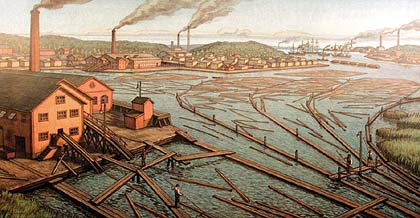
Image: The Provincial Museum of Kymenlaakso (PMK)
It was all based on waterways. The River Kymi waterway system
was an excellent transport
route from the inland forests to
the coast, and the sea linked Finland
to the rest of the world.
The River Kymi delta area, the
present-day city of Kotka, went
through unprecedented industrial
growth between 1871 and 1876,
when nine steam-driven sawmills
were founded. Their capacity totalled
just over one fifth of the production
of the whole country.
ja sen jälkeen vielä väliotsikko
FROM A SAWMILL VILLAGE TO A PULP COMMUNITY
The Sunila sawmill company got its production running in 1875 with backing from Swedish capital. An industrial community run by the factory owner was created, with its attendant wooden dwellings, primary school and library.
The journey, coloured with several changes in ownership, losses and smaller successes, continued until 1928 when, as a result of a business deal, the sawmill ceased operating and the workforce of almost 300 people was laid off. It was the beginning of a quiet period that lasted for almost a decade and ended only with the economic boom of the 1930s.
The Sunila sawmill and its surrounding area came under the ownership of the Kymenlaakso forest industry in 1928. Buyers in the ground-breaking joint venture were the companies Enso-Gutzeit, Halla, Aktiebolag Stockfors, Kymi, Yhtyneet Paperitehtaat [United Paper Mills], Karhula, and Tampereen Pellava- ja Rautateollisuus [Tampere flax and iron industry]. The acquisition of the area seems to have been aimed purely towards future strategic goals.
After the mid-1920s the emphasis of the forest industry began to move from the dominance of sawed timber products towards the production of pulp. The percentage of products derived from the sawmill industry then accounted for 45% of total Finnish exports, whereas the percentage of pulp and paper industry products was under 30%. However, within ten years the figures had changed; sawmill industry products accounted for 25%, and pulp and paper industry products for 40%.
With the beginning of the economic boom in the 1930s Sunila's time had arrived. The five joint company owners, A. Ahlström, Enso-Gutzeit, Kymi, Tampella and Yhtyneet Paperitehtaat [United Paper Mills] decided in 1936 to found the Sunila sulphate cellulose factory, the production capacity of which would be 80,000 tons per year.
The design stages and construction, the quarrying of the rocky building plot on the island of Pyötinen, the completion of road and rail connections, as well as the harbour jetty took only two years. The completion of the first pulp bail was celebrated on 16th May 1938.
The future, however, is always unpredictable. Economic fluctuations, variations in demand and changes in the global situation with the heavy war years gathered obstacles in the path of bold development. The aimed-for production capacity wasn't achieved until 1951.
Construction of the housing area began at the same time, and proceeded at the same brisk pace, as the factory. Housing for the factory management, office clerks, foremen and part of the workforce was competed in 1937.
- Sirkka Soukka
» PDF (3,7Mb)
|

|
|
